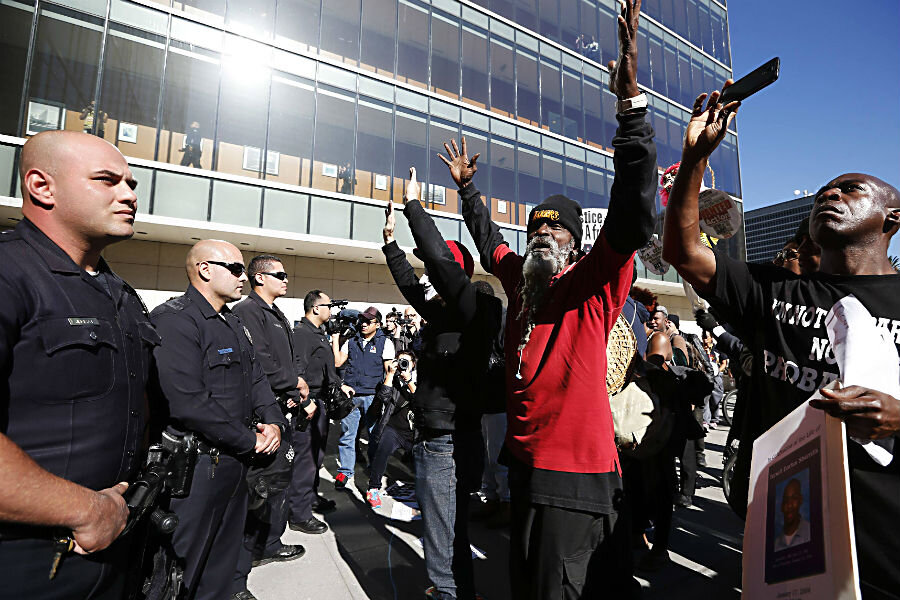LAPD shooting of homeless man raises questions around police training
Loading...
As the investigation into the fatal shooting of a homeless black man by Los Angeles Police Department (LAPD) officers unfolds, it raises questions about the effectiveness of police training and how officers respond in the heat of the moment, say law enforcement experts.
“One thousand one, one thousand,” says Reggie Allard, a retired police trainer, who worked at the Connecticut Police Training Academy, says in a phone interview. “That’s about one-point-five seconds. It’s how long it takes an average officer to draw a gun from a retention holster. It takes the same amount of time for someone to snatch the officer’s gun away. That's why training is critical to officers.”
On Sunday, four LAPD officers tussled with a homeless man who was a robbery suspect. Stun guns fired at the man had "appeared to have little effect and he continued to violently resist," LA Police Chief Charlie Beck told reporters. In the encounter, caught on video, one of the officers shouts 'He has my gun. He has my gun.' Seconds later, five gunshots were heard. “Los Angeles Fire Department paramedics responded and pronounced the suspect deceased at the scene," according to a statement released by the LAPD.
As the Associated Press reported, Sunday's incident had echoes of the August police shooting of 25-year-old Ezell Ford, a mentally ill black man, whose death in a struggle with LA officers triggered demonstrations in the city. Ford was unarmed. Police said he was shot after reaching for an officer's gun.
These types of incidents, Mr. Allard says, are why police training requires lessons in gun retention, as well as how to defuse the emotional level in such situations.
"CIT (Crisis Intervention Training) is a 40-hour week-long course – and that's before you get to weapon retention and even then you get reasonable mistakes in perception in the heat of the moment," says Allard, of Southington, Conn, who has 34 years of police experience, and a Masters Degree in criminal justice. "Also, there isn't a police academy in the U.S. that doesn't teach dealing with special needs and mentally ill."
In fact, LAPD Chief Beck told reporters that some of the officers had "completed our most extensive mental illness training over a 36-hour course."
As in all officer-involved shootings, LAPD's specialized Force Investigative Division (FID) personnel responded to preserve and collect evidence and interview witnesses to the incident. Videos of the incident captured by various sources – police body cams, bystander smartphones, and a security camera at a nearby homeless shelter – will be reviewed and analyzed as part of the ongoing use of force investigation, says the police statement.
“If you’re watching the videos of the LAPD shooting and killing a homeless man – who they say tried to grab the officer’s weapon – and making judgments based on what you see, think of two things: Video is a perspective, it’s not a perception. The perception of the of the officer, in that one-point-five seconds is what this is all about," says Allard.
“Video has the luxury of time and distance that an officer on the scene doesn’t have,” he says.
Of course, the perception of the public and how police are seen as handling black suspects is another issue. L.A. Mayor Eric Garcetti said he and the police chief have been transparent and have respond quickly to reassure residents that there is a robust investigation into the shooting.
According to Michael Lyman, a former criminal investigator and professor of criminal justice at Columbia College in Columbia, Mo., this incident is also an issue of where the officer’s gun was at the time of the shooting.
“The key word here is de-escalation,” Prof. Lyman says. “It’s not like a bank robbery. These officers knew they were going into a skid row area."
Asked what officers in that kind of situation need to be trained to know, he says: "They all needed to know you don’t crowd a suspect who is mentally ill. You don’t threaten arrest. You don’t surround. Maybe most of them knew those things but if one did not…absent proper training in even one team member means an encounter with a mentally ill person is not going to go well for anyone involved.”
Lyman says he would also want to know, “Was the gun in its retention holster and being grabbed for during a ground fight between the officer and the homeless man,” he asks during a phone interview. “Or was the gun already drawn before they hit the ground struggling over it?”
Lyman says, “If the victim was not in possession of the gun then the use of deadly force is not justified. If he was in possession of the weapon it’s an entirely different situation.”








